 |
Picks is a monthly sampling of Japan's art scene, offering short reviews of exhibitions at museums and galleries in recent weeks, with an emphasis on contemporary art by young artists. |
 |
 |
|
|
 |
 |
 |
 |
| Yokohama Triennale 2011 |
| 6 August - 6 November 2011 |
BankART Studio NYK / Yokohama Museum of Art
(Kanagawa) |
 |
| This is the harbor city's fourth Triennale. Of its two main venues, the installations filling the vast NYK Waterfront Warehouse seem to lack any coherent connection to one another, while the Yokohama Museum of Art is more successful both in its choice of works and their layout. But at a time when Japan has more than its share of uninspiring international art shows, overall this year's Triennale ranks on a par with the stunning 2005 effort directed by Tadashi Kawamata.
|
|
 |
 |
 |
 |
|
|
BankART Life III: Shin Minatomura
|
| 6 August - 6 November 2011 |
Shinko Pier, Yokohama
(Kanagawa) |
 |
As one of a number of tie-up programs with the Yokohama Triennale, BankART 1929 has made bold use of the cavernous new exhibition space at the end of Shinko Pier. With the aim of turning it into a village of sorts, the hall has been subdivided into galleries, studios, booths showcasing various regional art NPOs, a theater and a cafe, all connected by a maze of corridors and catwalks. Alas for this reviewer, one of the most intriguing installations, a zone left to the whims of several up-and-coming young architects, was still under construction at opening time. Then again, seeing this "village" take shape over the course of the event may prove to be one of its highlights.
|
|
|
|
|

|
 |
 |
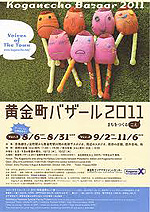 |
|
Koganecho Bazaar 2011 |
| 6 August - 6 November 2011 |
Koganecho and Hinodecho, Yokohama
(Kanagawa) |
 |
| Another special program affiliated with the Yokohama Triennale occupies an entire neighborhood. Not your typical neighborhood, however: once a notorious red-light district, Koganecho and Hinodecho have been transformed in recent years into a warren of artist studios, offering art instead of love for sale. It makes for a (good, clean) fun stroll from venue to venue. The scale of the ateliers and the works on display is generally diminutive, but the content is experimental and adventurous. Noteworthies include Nobuhiro Shimura and Takahiko Higuchi at Ryugu Bijutsu Ryokan ("Dragon Palace Art Inn"), and Takayoshi Kitagawa and Yosuke Amemiya at Hachiban-kan. |
|
|
 |
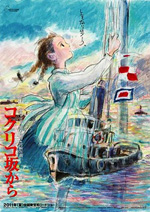 |
|
Kokurikozaka kara (From up on Poppy Hill) |
|
|
Toho Cinemas
(All over Japan) |
 |
| The latest Studio Ghibli product, this animated film was much touted as the second directorial effort by Goro Miyazaki, son of gray eminence Hayao. Set in early-sixties Yokohama, it is a lovely exercise in nostalgia: the vividly delineated architecture is as much a protagonist as the human characters. The Quartier Latin, the building around which much of the plot revolves, evokes the Kofu-in, a Meiji-era hall in Kyushu renovated by the late architect Yasufumi Kijima. But it also seems on the verge of morphing into the giant bathhouse in "Spirited Away." |
|
|
|
|
|
|
|

|
 |
 |
|
|
|
|
|
 |
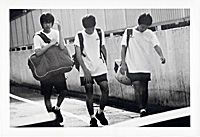 |
 |
|
|
Nobuyoshi Araki: Higan
|
|
22 July - 25 September 2011
|
Rat Hole Gallery
(Tokyo) |
 |
| Photographer Araki has long declared that the principle underlying his work is what he calls Erotos: the struggle between Eros (sex, life) and Thanatos (death). Certainly these forces, like attraction and repulsion, vie with one another in much of his work, which barely manages to keep them balanced in a tension-fraught embrace. In his current show, however, that balance appears to be tipping toward Thanatos, which hovers like a cloud over these works, while Eros seems to have taken its mischievous vivacity and quietly slipped away. |
|
|
|
|
|
|
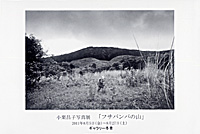 |
 |
|
|
Masako Oguri: Fusabanba no Yama (Grandmother's Mountain)
|
|
5 - 27 August 2011
|
Gallery Tosei
(Osaka) |
 |
| Photographer Oguri has lived for several years in the remote Tohoku town of Tono, where she shot these poignant monochrome images of an elderly, recently widowed farming woman she befriended. Having experienced the March 11 earthquake firsthand, Oguri writes, "Countless people perished in an instant, each one a single, irreplaceable life. I am now trying to keep those lives in mind as I reevaluate my own life and my work with the camera. There is something here, I feel, that needs to be communicated." |
|
 |
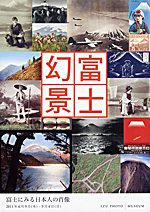 |
 |
|
| Visions of Fuji: A Portrait of the Japanese People as Seen through Mt. Fuji |
| 9 June - 4 September 2011 |
Izu Photo Museum
(Shizuoka) |
 |
| When one heads southwest from Tokyo for the resort areas of Izu or Hakone, the crucial question is always, will Fuji be visible? A clear view of the peak soaring grandly into a blue sky is bound to bring joy to any traveler; if it is obscured by clouds, we can't help but be disappointed. This ambitious show -- at a museum nestled in Fuji's foothills -- traces the ebb and flow of the iconic mountain's symbolic life as portrayed in photos from the last days of the Shogunate, through the Meiji period, and up to the present. |
|
|
|
|
 |
|
|
 |
|